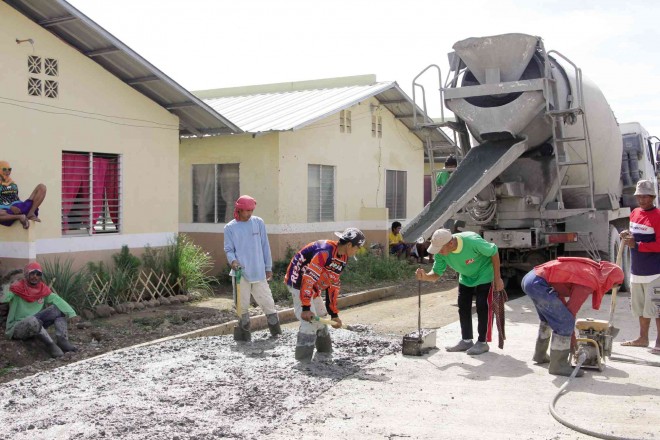‘Sendong’ survivors back to danger zones

WHILE continuing to struggle with their loss and pain, survivors are still rebuilding their lives in resettlement sites in Cagayan de Oro City two years after. CAI PANLILIO/INQUIRER MINDANAO
CAGAYAN DE ORO CITY—Two years after the devastation of Tropical Storm “Sendong,” Saturnino Zambrano is back in Sitio Cala-Cala in Barangay (village) Macasandig, which has been declared a danger zone by the city government.
His current residence is the only concrete structure left standing after Sendong’s wrath. He is a caretaker of a house that stands a few meters away from a cross, a memorial for those who lost their lives in the flash floods.
Zambrano, 64, was born and raised in Cala-Cala. Until two years ago, he and his family enjoyed having a small vegetable garden outside their house and a view of the Cagayan de Oro river, and he served as one of the watchmen in their barangay. But since Sendong, everything in his life had changed.
“I lost my land, my home … The experience that my wife and I went through that night will forever haunt me,” he said.
With tears trickling down his wrinkled cheeks, Zambrano recalled how he and his wife miraculously survived the wrath of the flash floods that damaged most of Cala-Cala.
Article continues after this advertisementThe floodwaters were already neck-deep when their house was washed away. He and his wife were swept toward an acacia tree. The fast-rising water pushed them up to the branches, so they were able to take refuge there.
Article continues after this advertisement“We were holding on to the branches for about 10 hours … It was very tiring but we kept thinking that one of us had to survive so our children would know what happened,” he said.
When they were rescued, Zambrano recalled seeing dead bodies, mostly of children and the elderly, scattered all over Cala-Cala.
“Until now, I cannot forget those images … Those people were so helpless. Some of us were just really fortunate to have survived,” he said.
While some survivors opted to stay in their villages, most did not have a choice but to avail of the housing program in several relocation sites several kilometers from the city proper.
Augustus Abcede, 53, is one of the residents of the Barangay Macapaya resettlement site. He has been living in the area for a year now and is also the current president of Macapaya Hills Oro Settlers Association Inc. Like so many others, he too, lost people dear to him.
“I lost two of my children, a grandchild and 12 other relatives to Sendong. Until now, their bodies have not been found … What choice do I have but to move on?” he said.
They did not expect, however, to face so much difficulty in the resettlement site.
“We do not have access to water and electricity … The government used to send fire trucks every day so we could have access to water but after the national and local elections last May, the fire trucks stopped coming,” he added.
Residents have to purchase water in Barangay Indahag, a few kilometers away from Macapaya. But delivering water to this resettlement site has posed many challenges. The only available transportation residents have is a motorcycle with a sidecar. Also, the roads leading to the area is still not properly paved.
For their electricity needs, the residents have been using candles and oil lamps in the evening.
“The residents have started to express their desire to move out of the resettlement site and rent a small place within the city proper … Life is just becoming too difficult for us here,” he said.
Most of the residents in Macapaya used to have jobs as laundry women and taxi drivers in the city proper.
Nelia Mason, a board director of the settler’s association, said they had members who were granted housing units but because of the difficulties, they opted to stay in the danger zones. These people, however, use the housing units whenever barangay officials announce a preemptive evacuation.
Mayor Oscar Moreno said the problem with some of the resettlement sites for the Sendong survivors was that there were no master plans before they were developed. That was why the potential problems were not properly addressed, he said.
“I inherited the problems on site development, such as the roads, drainage systems, water source and electricity … We are, however, modifying this in other resettlement sites by making a site development plan first,” he said.
Moreno was referring to the informal settlers within the city, which he intended to include in future relocation sites.
Ramon Fernandez, chair of the newly created Shelter and Housing Development Multi-Sectoral Task Force, said there were still about 2,100 applicants for resettlement sites to date.
Tonight, survivors of Sendong will gather at the memorial in Cala-Cala to offer candles and flowers to their lost loved ones. Zambrano is looking forward to this event.
“It is a time when we, the survivors, gather to console one another … We need this because two years have passed but we still have not recovered from it,” he said. Cai Panlilio, Inquirer Mindanao